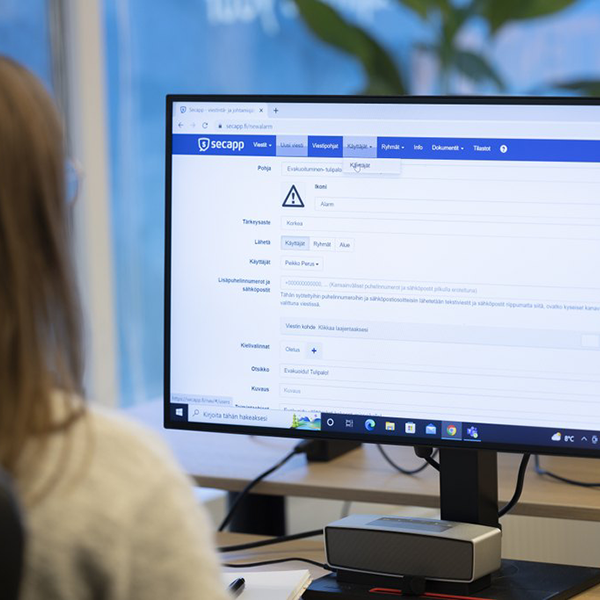The energy crisis, preparedness, reducing electricity consumption and potential power cuts during the winter are challenges that must be tackled not only in households but also by companies, organizations and municipalities.
How to prepare as well as possible against power cuts and to ensure continuity of various operations and the safety of employees during a power cut?
Check out these tips on how to prepare for power cuts and communicating about disruptions!

Whether a power cut is planned or unexpected, it can cause a variety of challenges to the company’s operations. A power cut, even a short one, can cause major costs in industry, for example, if processes are interrupted or production machines possibly breaking as a result.
For example, the warming of refrigeration equipment in an industrial kitchen may cause losses of thousands of euros, and an unplanned break in a production plant may result in the same amount of losses within minutes. In such a case time really is money.
In addition to ensuring that electrical equipment and IT systems continue to operate, you also have to prepare for the eventuality that nothing running on electricity is working. You have to consider during a power cut how to deal with water distribution (and frozen pipes), elevators, parking booms, any electric locks on doors, heating and lighting to ensure that the safety of the staff is not compromised.
1. Make a contingency plan and save electricity
Regardless of the company’s sphere of operation, it is equally important for all to be properly prepared in terms of the company’s operating environment. Companies should examine their own operating environment and find out what a power cut would mean to their particular business and processes.
What are the most critical factors and key persons during a power cut? This is why you must make a contingency plan. Take into account at least the following:

✔ Operation of equipment and working environment
IT systems, machines, equipment, locks, lighting, heating, back-up power generator, etc.
✔ Safety of employees
Will the equipment cause danger, can you touch them if they have not been properly shut down? Check that nobody is locked up somewhere in the dark. Instructions for staff, batteries, flashlights, etc.
✔ Communication about the disturbance, and responsibilities
Communication before, during and after a disturbance. Who will be sending information, to whom, and in which channel? Who will operate the back-up power generator, who checks the equipment, who is coordinating, and how is the situation monitored?
✔ Saving energy
In order to prevent planned power cuts, it is important to try to save energy in your daily operations. In the office or wherever you work, you can reduce the temperature, wear woolen socks, switch off lights that are not needed, and switch off equipment instead of having them in standby mode. Municipalities can save in street lighting. Find out the most practical ways you can save energy in your own organization.
2. Adopt suitable tools for emergency communication
When preparing for electricity distribution problems, it is also important to plan how communication is taken care of between the various parties. For that, you must have a reliable channel to ensure that messages are received during critical situations, saving precious seconds.
The goal is the same for every industry – to minimize the effect on your operations during a power cut.

✔ Be prepared by having the operating procedures ready. Remember to account for all parties (management, employees, stakeholders)
✔ Make sure the procedures are easily accessible and applicable to prevent human errors and to ensure that everyone knows how to act.
✔ Apply the same solution in various locations to familiarize people with the procedures.
Secapp Oy’s Chief Business Officer Jani Lehtinen has long experience in developing the Secapp product to meet customer needs, right from the beginnings of the company. Secapp as a product operates at the heart of critical communications, as it was developed in cooperation with emergency services to enable the best possible operation of critical communication and to ensure quick response. Lehtinen underlines the importance of communication in preparation:
Effective communication and its planning are key aspects of good preparation regardless of whether we are talking about an industrial company, municipality, wellbeing services county or anything else. Whatever the sector, quick flow of information is crucial in order to reach the right people when the need arises.
Secapp has helped many organizations to improve their preparedness and speeded up the time to alert people by as much as 90%. Thanks to the automated communication and multichannel operation, the right people can be reached quickly, wherever they may be located. Secapp can do this in seconds, also creating a real-time situational picture to support decision-making. By means of message templates and automation, Secapp also minimizes human errors.
Good preparation is half the job
Having a communication channel is not quite enough, though. Good preparation is half the job. Doing the first half is the key – when you not in a hurry or in the middle of an emergency. Jani Lehtinen says that in addition to a communication channel, you need clear messages for different target groups and different situations.
Various scenarios and message templates related to them should be completed in advance, detailing what information is sent to whom and who is in charge of what. Templates for every group, for management and for people in charge of machines, and one for the entire staff, all depending on the organization’s needs.
Message templates are easy to create in Secapp. You should write clear instructions for various recipient groups, and also test them in practice in advance. This can prevent errors caused by slip-ups made in a hurry, for example.
When the actual need arises, the messages can be sent with just a few clicks, taking no longer than a few seconds.
Lehtinen goes on to explain that Secapp communication occurs in multiple channels – information can be sent within seconds to thousands of recipients in a number of channels. Another important feature is that the application attracts the recipient’s attention better than an email message, which can be overlooked as people receive so many of them. The system is bidirectional, meaning that an immediate acknowledgment is received, giving valuable information when the message has been reacted to and to see how the situation progresses.
3. Ensure data security and safety of employees and operating environment
When it comes to preparation and information that is critical to a company, it is also important that messages are delivered reliably and remain secure, and inaccessible to outsiders.
“This is why WhatsApp or similar quick messaging services designed for the general public are not recommended,” says Jani Lehtinen.
WhatsApp, for example, shares all the user’s contact details on servers, and there is no easy way to remove anyone, such as former employees, from a group.

If even a single user takes a backup copy of their WhatsApp discussions, they will stored in Google or similar. Moreover, any information going through WhatsApp is not managed by the organization, and therefore not safe from outsiders. Any unexpected breaks in service are critical with tools based on a single channel.
Secapp messages are delivered safely and reliably, and the contact details and discussions remain within the organization. During a long power cut, the base stations of mobile networks continue to operate for at least a few hours, so the messages will reach the recipients. Secapp operates not only in mobile networks but also with WiFi connections, fixed connections and in VIRVE, Finland’s Authority Radio Network.
Secapp is a secure system, and all customer data is fully owned by the customer. It is a software as a service (SaaS), and all data is stored on Finnish servers. The functions are distributed on multiple servers so that if any problems occur, another server will take over within seconds. The cloud service is secure, as critical communication will go through even if there was a disruption in the customer’s own operating environment.
Don’t forget the all-important safety instructions
When communicating, it is important to create a feeling of security: with messages prepared in advance to convey calmness and complete with clear instructions of how to act, recipients get the feeling that the situation is under control and there is no cause for panic.
In general, you should send the first message as soon as you know that a power cut is coming – you can rarely send too much information.

Many safety issues also require good instructions, such as matters related to a production shutdown. Power cuts can have knock-on effects that may affect the use of equipment once the situation returns to normal. This is why you need to send good instructions to staff to ensure their safety. Instructions and checklists must be prepared carefully – and also test them with users. Also make sure that the necessary instructions are placed in the vicinity of the equipment.
If there is a sudden power cut and there is no back-up power for some reason, be prepared to inform the staff quickly and to ensure their safety, telling them, for example, where flashlights can be found or how to call for help if anyone is stuck behind a locked door or caught in a dark stairwell.
Unexpected and dangerous situations can nevertheless occur. Secapp’s lone working safety application alerts for help either with a one-click alert button or a physical safety button connected to Secapp. The message recipient will automatically receive the location of the person needing help.
4. Test and practice
Once a plan is in place, you must also test it in practice. Select a quiet weekend or similar for testing. Organize a drill with all the key persons involved. Test also how the communication works.
It is equally important to discuss the drill afterwards. What was good, what needs to be improved? Go through any issues and update the plan accordingly.

“Many of our customers organize regular preparedness exercises in case of crisis situations, and Secapp plays a key role in that as a tool for communication and providing a situational picture,” says Lehtinen.
For example, the Radiation and Nuclear Safety Authority (STUK) simulates alarm situations regularly to ensure that they will act efficiently and correctly when the need arises. Secapp is also excellent for daily communication – and indeed that is what it is also used for at STUK.
When using the system becomes a routine, there is no trouble using it also when serious things happen. No need to look for instructions or learning to use the system.
5. Act NOW
If you have not quite thought through how to prepare for power cuts, no problem. Lehtinen says that today more than 800 organizations are using Secapp:
You are familiar with your equipment, premises and staff that a power cut may affect. We at Secapp, on the other hand, are experts at critical communication and will help you to set up a system. It’s not just something you put aside “just in case it’s needed”. Secapp already helps more than 800 organizations in daily routines and communication and improves employee safety.
Many people may be intimidated by long launch processes of new systems and learning to use them, but there are no such fears with Secapp.
Secapp can be set up in about one day, so there is no need to hesitate,” says Lehtinen.
Secapp requires no installations or separate equipment. You receive online training lasting an hour or two, after which it’s all there. The system has been praised for being quick to learn and easy to use.
And now that preparing for power cuts is important, basic message templates come with the package, getting you started even better.
Our values include protecting our customers. The energy crisis affects us all, and with our system organizations can be better prepared and maintain operations in our society better.
Secapp has a variety of features, but the best thing is that you can only use the ones that you need. More features can be easily brought in later.
This is how Secapp helps:
- Targeted communication to groups: such as management, safety staff, IT department, entire staff, etc.
- Multichannel: Messages are sent through multiple channels, overriding silence settings, if necessary: Secapp mobile application, browser application, text message, email, VIRVE.
- Bidirectionality: Immediate acknowledgment from the recipients helps to create a quick picture of the situation, with up-to-date knowledge of what has already been taken care of.
- Message templates: By creating message templates for various groups, communication is quick. Communication can also be automated, reducing human errors.
- Lone working safety
- This can be integrated into the organization’s existing alarms and safety systems.
Vendor Collaboration Ensures Success: Eloisa and Secapp Partnership Adds Value to System Utilization
The South Savo Wellbeing Services County, i.e. Eloisa, emphasizes vendor collaboration with Secapp. The systematic and efficient implementation and ...
Secapp in the manufacturing industry – return on investment
This article is the final part of the Secapp in the Manufacturing Industry serial. The three-part ...
The benefits of Secapp in the manufacturing industry
This article is the second part of the Secapp in the Manufacturing Industry serial. The three-part ...
The energy crisis, preparedness, reducing electricity consumption and potential power cuts during the winter are challenges that must be tackled not only in households but also by companies, organizations and municipalities.
How to prepare as well as possible against power cuts and to ensure continuity of various operations and the safety of employees during a power cut?
Check out these tips on how to prepare for power cuts and communicating about disruptions!

Whether a power cut is planned or unexpected, it can cause a variety of challenges to the company’s operations. A power cut, even a short one, can cause major costs in industry, for example, if processes are interrupted or production machines possibly breaking as a result.
For example, the warming of refrigeration equipment in an industrial kitchen may cause losses of thousands of euros, and an unplanned break in a production plant may result in the same amount of losses within minutes. In such a case time really is money.
In addition to ensuring that electrical equipment and IT systems continue to operate, you also have to prepare for the eventuality that nothing running on electricity is working. You have to consider during a power cut how to deal with water distribution (and frozen pipes), elevators, parking booms, any electric locks on doors, heating and lighting to ensure that the safety of the staff is not compromised.
1. Make a contingency plan and save electricity
Regardless of the company’s sphere of operation, it is equally important for all to be properly prepared in terms of the company’s operating environment. Companies should examine their own operating environment and find out what a power cut would mean to their particular business and processes.
What are the most critical factors and key persons during a power cut? This is why you must make a contingency plan. Take into account at least the following:

✔ Operation of equipment and working environment
IT systems, machines, equipment, locks, lighting, heating, back-up power generator, etc.
✔ Safety of employees
Will the equipment cause danger, can you touch them if they have not been properly shut down? Check that nobody is locked up somewhere in the dark. Instructions for staff, batteries, flashlights, etc.
✔ Communication about the disturbance, and responsibilities
Communication before, during and after a disturbance. Who will be sending information, to whom, and in which channel? Who will operate the back-up power generator, who checks the equipment, who is coordinating, and how is the situation monitored?
✔ Saving energy
In order to prevent planned power cuts, it is important to try to save energy in your daily operations. In the office or wherever you work, you can reduce the temperature, wear woolen socks, switch off lights that are not needed, and switch off equipment instead of having them in standby mode. Municipalities can save in street lighting. Find out the most practical ways you can save energy in your own organization.
2. Adopt suitable tools for emergency communication
When preparing for electricity distribution problems, it is also important to plan how communication is taken care of between the various parties. For that, you must have a reliable channel to ensure that messages are received during critical situations, saving precious seconds.
The goal is the same for every industry – to minimize the effect on your operations during a power cut.

✔ Be prepared by having the operating procedures ready. Remember to account for all parties (management, employees, stakeholders)
✔ Make sure the procedures are easily accessible and applicable to prevent human errors and to ensure that everyone knows how to act.
✔ Apply the same solution in various locations to familiarize people with the procedures.
Secapp Oy’s Chief Business Officer Jani Lehtinen has long experience in developing the Secapp product to meet customer needs, right from the beginnings of the company. Secapp as a product operates at the heart of critical communications, as it was developed in cooperation with emergency services to enable the best possible operation of critical communication and to ensure quick response. Lehtinen underlines the importance of communication in preparation:
Effective communication and its planning are key aspects of good preparation regardless of whether we are talking about an industrial company, municipality, wellbeing services county or anything else. Whatever the sector, quick flow of information is crucial in order to reach the right people when the need arises.
Secapp has helped many organizations to improve their preparedness and speeded up the time to alert people by as much as 90%. Thanks to the automated communication and multichannel operation, the right people can be reached quickly, wherever they may be located. Secapp can do this in seconds, also creating a real-time situational picture to support decision-making. By means of message templates and automation, Secapp also minimizes human errors.
Good preparation is half the job
Having a communication channel is not quite enough, though. Good preparation is half the job. Doing the first half is the key – when you not in a hurry or in the middle of an emergency. Jani Lehtinen says that in addition to a communication channel, you need clear messages for different target groups and different situations.
Various scenarios and message templates related to them should be completed in advance, detailing what information is sent to whom and who is in charge of what. Templates for every group, for management and for people in charge of machines, and one for the entire staff, all depending on the organization’s needs.
Message templates are easy to create in Secapp. You should write clear instructions for various recipient groups, and also test them in practice in advance. This can prevent errors caused by slip-ups made in a hurry, for example.
When the actual need arises, the messages can be sent with just a few clicks, taking no longer than a few seconds.
Lehtinen goes on to explain that Secapp communication occurs in multiple channels – information can be sent within seconds to thousands of recipients in a number of channels. Another important feature is that the application attracts the recipient’s attention better than an email message, which can be overlooked as people receive so many of them. The system is bidirectional, meaning that an immediate acknowledgment is received, giving valuable information when the message has been reacted to and to see how the situation progresses.
3. Ensure data security and safety of employees and operating environment
When it comes to preparation and information that is critical to a company, it is also important that messages are delivered reliably and remain secure, and inaccessible to outsiders.
“This is why WhatsApp or similar quick messaging services designed for the general public are not recommended,” says Jani Lehtinen.
WhatsApp, for example, shares all the user’s contact details on servers, and there is no easy way to remove anyone, such as former employees, from a group.

If even a single user takes a backup copy of their WhatsApp discussions, they will stored in Google or similar. Moreover, any information going through WhatsApp is not managed by the organization, and therefore not safe from outsiders. Any unexpected breaks in service are critical with tools based on a single channel.
Secapp messages are delivered safely and reliably, and the contact details and discussions remain within the organization. During a long power cut, the base stations of mobile networks continue to operate for at least a few hours, so the messages will reach the recipients. Secapp operates not only in mobile networks but also with WiFi connections, fixed connections and in VIRVE, Finland’s Authority Radio Network.
Secapp is a secure system, and all customer data is fully owned by the customer. It is a software as a service (SaaS), and all data is stored on Finnish servers. The functions are distributed on multiple servers so that if any problems occur, another server will take over within seconds. The cloud service is secure, as critical communication will go through even if there was a disruption in the customer’s own operating environment.
Don’t forget the all-important safety instructions
When communicating, it is important to create a feeling of security: with messages prepared in advance to convey calmness and complete with clear instructions of how to act, recipients get the feeling that the situation is under control and there is no cause for panic.
In general, you should send the first message as soon as you know that a power cut is coming – you can rarely send too much information.

Many safety issues also require good instructions, such as matters related to a production shutdown. Power cuts can have knock-on effects that may affect the use of equipment once the situation returns to normal. This is why you need to send good instructions to staff to ensure their safety. Instructions and checklists must be prepared carefully – and also test them with users. Also make sure that the necessary instructions are placed in the vicinity of the equipment.
If there is a sudden power cut and there is no back-up power for some reason, be prepared to inform the staff quickly and to ensure their safety, telling them, for example, where flashlights can be found or how to call for help if anyone is stuck behind a locked door or caught in a dark stairwell.
Unexpected and dangerous situations can nevertheless occur. Secapp’s lone working safety application alerts for help either with a one-click alert button or a physical safety button connected to Secapp. The message recipient will automatically receive the location of the person needing help.
4. Test and practice
Once a plan is in place, you must also test it in practice. Select a quiet weekend or similar for testing. Organize a drill with all the key persons involved. Test also how the communication works.
It is equally important to discuss the drill afterwards. What was good, what needs to be improved? Go through any issues and update the plan accordingly.

“Many of our customers organize regular preparedness exercises in case of crisis situations, and Secapp plays a key role in that as a tool for communication and providing a situational picture,” says Lehtinen.
For example, the Radiation and Nuclear Safety Authority (STUK) simulates alarm situations regularly to ensure that they will act efficiently and correctly when the need arises. Secapp is also excellent for daily communication – and indeed that is what it is also used for at STUK.
When using the system becomes a routine, there is no trouble using it also when serious things happen. No need to look for instructions or learning to use the system.
5. Act NOW
If you have not quite thought through how to prepare for power cuts, no problem. Lehtinen says that today more than 800 organizations are using Secapp:
You are familiar with your equipment, premises and staff that a power cut may affect. We at Secapp, on the other hand, are experts at critical communication and will help you to set up a system. It’s not just something you put aside “just in case it’s needed”. Secapp already helps more than 800 organizations in daily routines and communication and improves employee safety.
Many people may be intimidated by long launch processes of new systems and learning to use them, but there are no such fears with Secapp.
Secapp can be set up in about one day, so there is no need to hesitate,” says Lehtinen.
Secapp requires no installations or separate equipment. You receive online training lasting an hour or two, after which it’s all there. The system has been praised for being quick to learn and easy to use.
And now that preparing for power cuts is important, basic message templates come with the package, getting you started even better.
Our values include protecting our customers. The energy crisis affects us all, and with our system organizations can be better prepared and maintain operations in our society better.
Secapp has a variety of features, but the best thing is that you can only use the ones that you need. More features can be easily brought in later.
This is how Secapp helps:
- Targeted communication to groups: such as management, safety staff, IT department, entire staff, etc.
- Multichannel: Messages are sent through multiple channels, overriding silence settings, if necessary: Secapp mobile application, browser application, text message, email, VIRVE.
- Bidirectionality: Immediate acknowledgment from the recipients helps to create a quick picture of the situation, with up-to-date knowledge of what has already been taken care of.
- Message templates: By creating message templates for various groups, communication is quick. Communication can also be automated, reducing human errors.
- Lone working safety
- This can be integrated into the organization’s existing alarms and safety systems.
Vendor Collaboration Ensures Success: Eloisa and Secapp Partnership Adds Value to System Utilization
The South Savo Wellbeing Services County, i.e. Eloisa, emphasizes vendor collaboration with Secapp. The systematic and efficient implementation and ...
Secapp in the manufacturing industry – return on investment
This article is the final part of the Secapp in the Manufacturing Industry serial. The three-part ...
The benefits of Secapp in the manufacturing industry
This article is the second part of the Secapp in the Manufacturing Industry serial. The three-part ...







